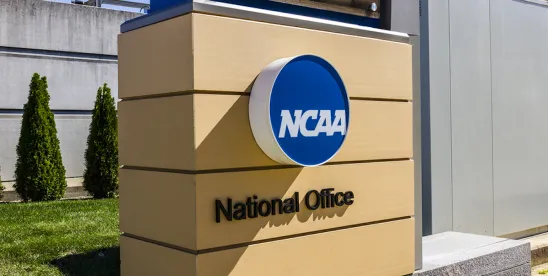The NCAA and Power Four conferences entered into a final settlement agreement (the Settlement) on June 6, 2025, resolving several pending lawsuits brought by college athletes over the use of their name, image, and likeness (NIL). These cases were combined into one called In re College Athlete NIL Litigation. The Settlement significantly changes the landscape of NIL rights and college athletics overall.
The Settlement includes several key provisions, including payments to current and former Division I athletes, revenue sharing, roster limits, and a new enforcement entity responsible for ensuring schools and athletes comply with NIL rules.
Back Payments to Former Athletes
The Settlement includes payment of $2.8 billion in damages to be paid over 10 years to certain former Division I athletes who played collegiate sports before NIL compensation was allowed in 2021. These payments are intended to compensate student athletes for revenue they could have earned if the previous prohibition on NIL and revenue sharing was not in place.
Direct Payments and Revenue Sharing
Under the new framework, student athletes can be paid directly by their schools using funds from a compensation pool. This pool is based on 22% of the average annual revenue of all participating institutions, estimated at $20.5 million in 2025. The pool will increase by 4% each year. Each school will use its portion of the pool to pay athletes across all sports and decide how to distribute the funds.
Elimination of Scholarship Caps
The Settlement removes limits on how many scholarships schools can grant per sport, allowing them to offer an unlimited number. However, any scholarship exceeding the old NCAA limits will count against a school’s compensation pool at the full cost of attendance. Scholarships offered within the previous NCAA limits will not reduce the school’s pool.
Introduction of Roster Limits
While the Settlement removes scholarship limits, it also imposes roster limits. The new roster limits allow schools to offer full or partial scholarships to all athletes on a team, rather than being limited to a fixed number of scholarships per sport. The issue of roster limits and its harm to current student athletes resulted in a delay of the final settlement approval. A provision was included to protect current athletes who may have lost roster spots due to the Settlement, allowing them to use the rest of their eligibility without penalty.
New Oversight and Reporting Platform
The Settlement requires the NCAA and Power Four conferences to establish an enforcement entity. This led to the creation of the College Sports Commission, which will be responsible for enforcing rules on roster limits, revenue sharing, and third-party NIL deals. The specific enforcement procedures will likely continue to evolve following the Settlement.
The College Sports Commission is expected to work with Deloitte to manage a new platform called NIL Go, which handles reporting and vetting third-party NIL deals. This platform will serve as a clearinghouse to vet any NIL agreements over $600 involving entities like boosters and collectives.
The Settlement introduces significant changes to college athletics and NIL, but it does not settle all outstanding issues. Whether student athletes should be considered employees by their schools and whether student athletes have the right to collectively bargain still needs to be decided.





 />i
/>i

